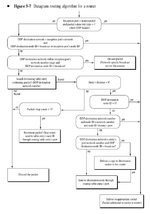Tashtari
PIC Whisperer
So I'm trying to put my (somewhat limited) networking knowledge into the creation of a flexible software AppleTalk router with support for TashTalk and LToUDP as well as EtherTalk and I've been perusing Inside AppleTalk to that end.
There is a nice flowchart of the routing algorithm on page 5-26 of IA which I've been trying to turn into code...

...unfortunately, it doesn't specify what to do in the case of a datagram or a port that has a network number of 0x00, and I'm altogether confused as to how to handle these cases.
Here's the relevant portions of my code so far, complete with TODOs where I'm not sure of things:
Anyone willing to have a look, perchance to provide some direction? =)
There is a nice flowchart of the routing algorithm on page 5-26 of IA which I've been trying to turn into code...

...unfortunately, it doesn't specify what to do in the case of a datagram or a port that has a network number of 0x00, and I'm altogether confused as to how to handle these cases.
Here's the relevant portions of my code so far, complete with TODOs where I'm not sure of things:
Python:
def network_eq(a, b):
'''Return whether network numbers are equivalent according to IA page 4-21.'''
return True if 0 in (a, b) or a == b else False
# ...
def process(self, rx_port, datagram):
'''Process a Datagram from a port, discarding or routing and/or delivering it as appropriate.'''
if not rx_port.extended_network and not datagram.long_ddp_header:
# deliver (we wouldn't have received this datagram if it wasn't meant for us directly)
self.deliver(datagram)
elif network_eq(datagram.destination_network, rx_port.network) and datagram.destination_node in (rx_port.node, 0xFF):
# deliver (this is the destination network and node, or this is the destination network for a broadcast)
self.deliver(datagram)
elif rx_port.network_min <= datagram.destination_network <= rx_port.network_max and datagram.destination_node == 0xFF:
#TODO how to handle zero dest network or range of 0-0 on rx_port?
# discard (network-specific broadcast not for this router)
pass
elif datagram.destination_network not in self.routing_table:
#TODO should we skip this case if dest network is 0?
# discard (can't get there from here)
pass
else:
#TODO if dest network is 0, should we loop through the below with all entries in the routing table?
entry = self.routing_table[datagram.destination_network]
if entry.distance != 0:
if datagram.hop_count < 15:
# route (here isn't there but we know how to get there)
entry.port.send(entry.network, entry.node, datagram.hop())
else:
# discard (excess hop count)
pass
elif datagram.destination_node == 0x00:
# deliver (special 'any router' address, see IA page 4-7)
self.deliver(datagram)
elif network_eq(datagram.destination_network, entry.port.network) and datagram.destination_node == entry.port.node:
# deliver (addressed to another port of this router's)
self.deliver(datagram)
else:
if network_eq(datagram.destination_network, entry.port.network) and datagram.destination_node == 0xFF:
# deliver (broadcast includes another port of this router's)
self.deliver(datagram)
# route (the destination is connected to us directly)
entry.port.send(datagram.destination_network, datagram.destination_node, datagram)Anyone willing to have a look, perchance to provide some direction? =)
